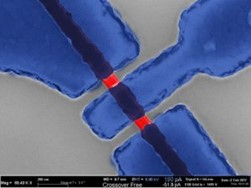Kick-starting supersonic waves in antiferromagnets

An artistic impression of the light pulse that locally shakes the spins in the antiferromagnet, which results in spin waves propagating into the material.
A team of researchers led by TU Delft, including R. Citro from UniSA, has demonstrated a new technique to generate magnetic waves in antiferromagnets that propagate through the material at a speed much larger than the speed of sound. These so-called spin waves produce a lot less heat than conventional electric currents, making them promising candidates for future electronic devices with significantly reduced power consumption.
Physicists and engineers from all around the world are constantly thinking of ways to improve the performance of conventional electronic devices. Many of their ideas revolve around substituting the electrical currents, which carry the signals in information processing devices, by waves. Waves are coherent excitations, which means that information can be encoded into both the amplitude and the phase of the wave. Interference and diffraction, natural phenomena for a wave of any nature, enable the creation of so-called wave-based logic circuits, the tiny building blocks for future data processing applications. Since waves travel through materials with significantly lower resistance than electric currents, they have the potential to drastically reduce power consumption in future electronics.
Nature Physics, 17, 1001-1006 (2021) url: https://www.nature.com/articles/s41567-021-01290-4!
